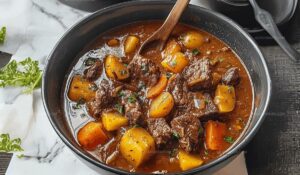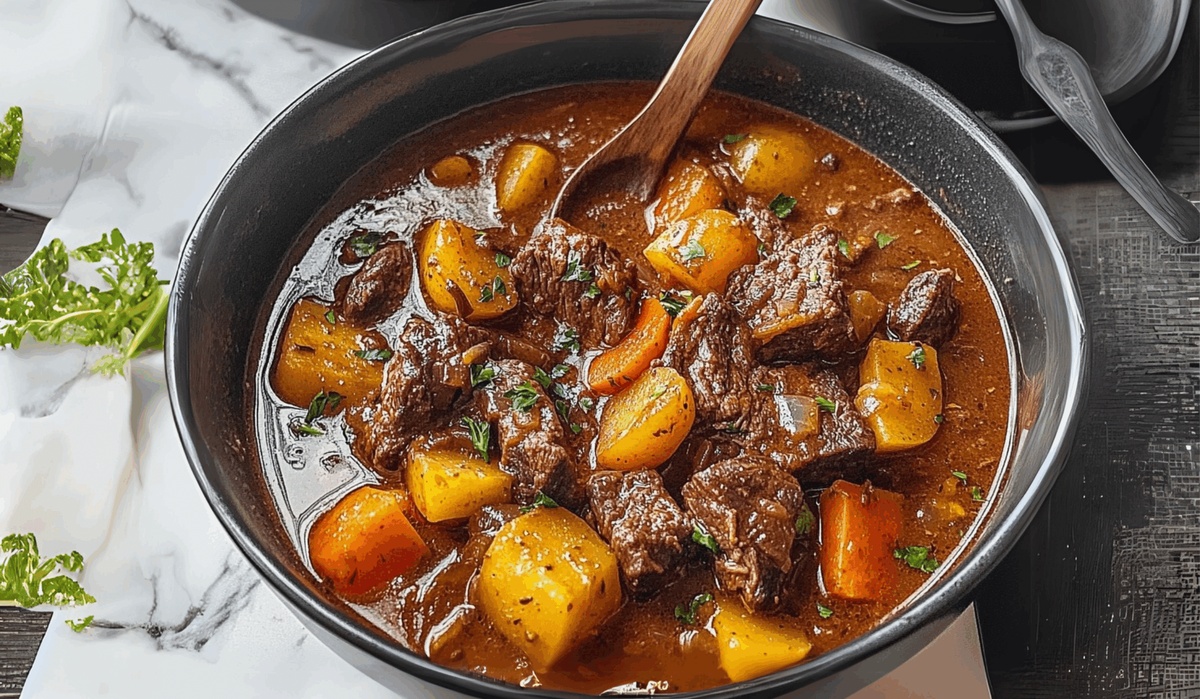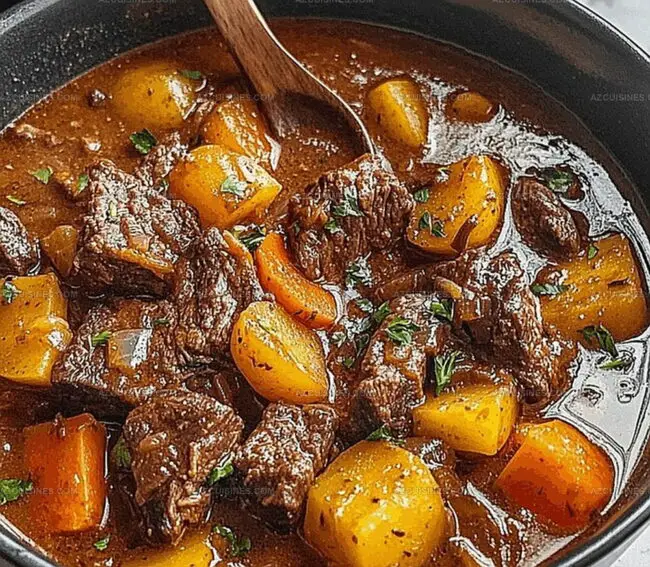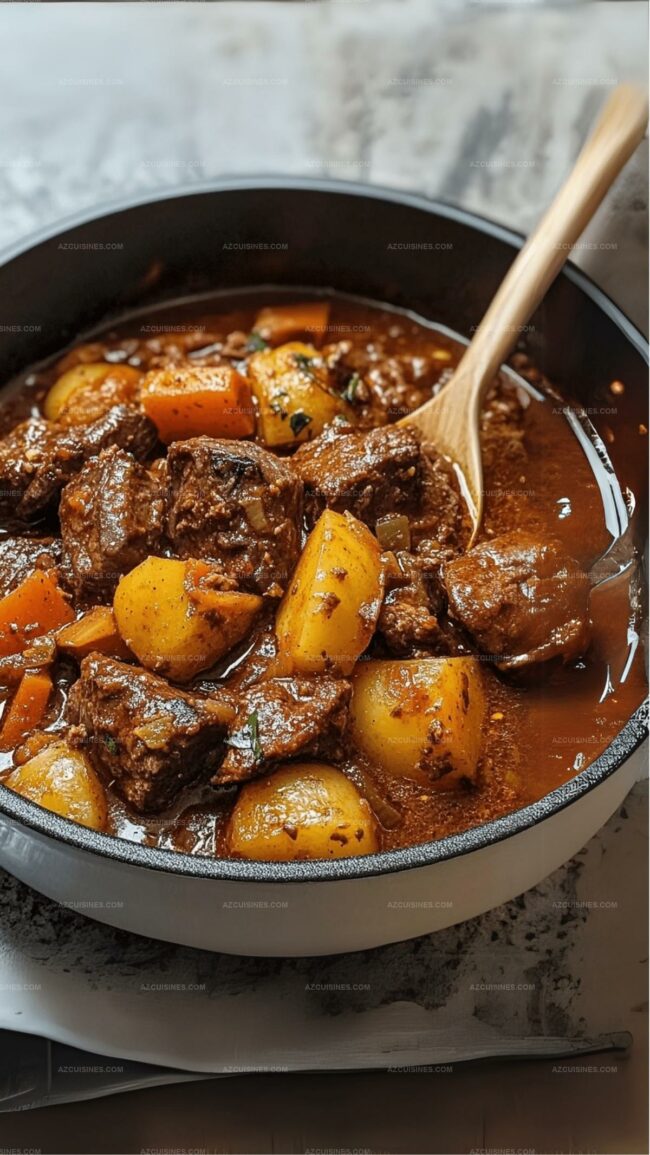Hearty Classic Beef Stew Recipe: Comforting Goodness in a Bowl
Hearty and comforting, this classic beef stew recipe promises a soul-warming meal that echoes generations of kitchen wisdom.
Tender chunks of meat melt into rich, velvety gravy after slow cooking.
Aromatic herbs and robust vegetables create layers of incredible depth and flavor.
Cold evenings call for something substantial and nurturing like this traditional dish.
Robust and satisfying, each spoonful brings warmth and memories of home-cooked goodness.
Moments around the table become magical when you share this delectable stew with loved ones.
Dive into a culinary experience that transforms simple ingredients into an extraordinary meal.
Why Classic Beef Stew Is A Cold-Weather Favorite
What You’ll Need For Classic Beef Stew
Main Protein:Aromatic Base:Liquid Components:Seasoning and Herbs:Thickening Agent:Vegetables:Cooking Fat:Optional Garnish:How To Cook Classic Beef Stew Step By Step
Step 1: Prepare Beef Chunks
Grab your beef and use paper towels to pat each chunk completely dry. Sprinkle generously with salt and black pepper, ensuring every piece gets seasoned evenly.
Step 2: Brown Beef Beautifully
Heat olive oil in a large Dutch oven over medium-high heat. Carefully place beef chunks into the hot pan, avoiding overcrowding. Sear each piece until a gorgeous golden-brown crust develops, working in multiple batches for perfect caramelization.
Step 3: Create Flavor Base
Remove browned beef and set aside. In the same pot, sauté:Cook until onions become translucent and incredibly fragrant.
Step 4: Build Stew Foundation
Sprinkle flour over the onion-garlic mixture. Stir constantly to create a smooth roux, preventing any burning. Cook for 1-2 minutes to eliminate raw flour taste.
Step 5: Develop Rich Liquid
Splash red wine into the pot, scraping up all those delicious browned bits from the bottom. Add:Stir everything together to combine flavors.
Step 6: Initiate Slow Cooking
Return beef chunks to the pot. Toss in bay leaves and dried thyme. Bring mixture to a gentle simmer, allowing flavors to mingle and develop.
Step 7: Braise to Perfection
Cover pot and reduce heat to low. Let stew slowly braise for approximately 1.5 hours, stirring occasionally to prevent sticking.
Step 8: Add Vegetables
Introduce:Continue cooking for 30-40 minutes until vegetables become tender and beef reaches melt-in-your-mouth softness.
Step 9: Final Touches
Remove bay leaves. Taste and adjust seasoning as needed. Let stew rest for 10 minutes to allow flavors to harmonize completely.
Step 10: Serve and Enjoy
Ladle steaming stew into warm bowls. Optional: Sprinkle fresh parsley on top for a burst of color and freshness. Serve immediately and watch everyone’s eyes light up!
Tips For Rich And Tasty Classic Beef Stew
Different Ways To Serve Classic Beef Stew
Best Pairings With Classic Beef Stew
How To Store Classic Beef Stew Properly
Classic Beef Stew Frequently Asked Questions
Patting beef dry helps create a perfect golden-brown crust by removing excess moisture, which allows for better caramelization and enhances the meat’s flavor during searing.
Braising the beef at a low, gentle simmer breaks down tough connective tissues, ensuring the meat becomes incredibly tender and soft after cooking for about 1.5 hours.
If you prefer not to use wine, you can replace it with additional beef broth or beef stock to maintain the depth of flavor in the stew.
Adding flour creates a roux that helps thicken the stew, giving it a rich, hearty consistency and helping to bind the sauce together.
Print
Classic Beef Stew Recipe
- Total Time: 2 hours 15 minutes
- Yield: 6 1x
Description
Hearty “Classic Beef Stew” brings comfort from grandma’s kitchen, delivering rich flavors that dance on hungry palates. Tender meat, savory vegetables, and robust broth promise a satisfying meal you’ll crave on chilly evenings.
Ingredients
Main Ingredients:
- 2 lbs beef chuck roast, cut into 1-inch cubes
- 4 large potatoes, peeled and chopped
- 3 medium carrots, sliced
- 2 medium onions, diced
Liquid and Seasoning:
- 4 cups beef broth
- 1/2 cup red wine
- 2 tbsp tomato paste
- 2 cloves garlic, minced
- 1 tbsp worcestershire sauce
Thickening and Herbs:
- 1/4 cup all-purpose flour
- 2 tbsp olive oil
- 2 bay leaves
- 1 tsp dried thyme
- 1 tsp salt
- 1/2 tsp black pepper
Instructions
- Pat beef cubes dry with paper towels to ensure proper browning and season generously with salt and pepper.
- Heat olive oil in a large Dutch oven over medium-high heat and sear beef chunks until golden brown on all sides, working in batches to avoid overcrowding.
- Remove browned beef and set aside, then sauté diced onions and minced garlic in the same pot until fragrant and translucent.
- Sprinkle flour over the onions and garlic, stirring constantly to create a roux and prevent burning, cooking for 1-2 minutes.
- Deglaze the pot with red wine, scraping up any browned bits from the bottom, then add beef broth, tomato paste, and worcestershire sauce.
- Return beef to the pot, along with bay leaves and dried thyme, and bring the mixture to a gentle simmer.
- Cover and reduce heat to low, allowing the stew to slowly braise for approximately 1.5 hours, stirring occasionally.
- Add chopped potatoes and sliced carrots to the pot, continuing to cook for an additional 30-40 minutes until vegetables are tender and beef is extremely soft.
- Remove bay leaves, taste and adjust seasoning as needed, and let the stew rest for 10 minutes before serving to allow flavors to meld.
- Ladle into warm bowls and serve hot, optionally garnishing with fresh parsley for added brightness.
Notes
- Choose tough, marbled cuts like chuck roast for maximum flavor and tenderness during slow cooking.
- Pat beef completely dry before searing to achieve deep golden-brown caramelization without steaming the meat.
- Work in small batches while browning beef to maintain high pan temperature and develop rich, complex flavor profiles.
- Consider using low-sodium broth to control salt levels and prevent overseasoning during the long braising process.
- Swap red wine with beef stock or additional broth for a non-alcoholic version that maintains robust taste.
- Add root vegetables like parsnips or celery root for extra depth and nutritional variety in the stew.
- Store leftovers in airtight containers for up to 4 days, noting that flavors will continue to develop and intensify overnight.
- Prep Time: 15 minutes
- Cook Time: 2 hours
- Category: Dinner, Lunch
- Method: Slow Cooking
- Cuisine: American
Nutrition
- Serving Size: 6
- Calories: 350
- Sugar: 3 g
- Sodium: 800 mg
- Fat: 15 g
- Saturated Fat: 4 g
- Unsaturated Fat: 9 g
- Trans Fat: 0 g
- Carbohydrates: 32 g
- Fiber: 4 g
- Protein: 25 g
- Cholesterol: 90 mg





Truc Tran (Kris)
Senior Food Editor
Expertise
Home Cooking, Meal Planning, Recipe Development, Baking and Pastry, Food Editor, Cooking-video Maker, Vietnamese Food Evaluation Expert
Education
Truc Tran (Kris), an experienced food writer and editor, is great at exploring and describing global cuisines, from simple street food to fancy dining. In her writing, she skillfully mixes different flavors, cooking methods, and culinary traditions, showing the unique character of various cultures through their food and drinks. On azcuisines.com, Kris highlights her knowledge, especially in Asian cuisine and worldwide traditional dishes.